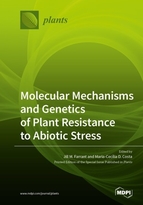Molecular Mechanisms and Genetics of Plant Resistance to Abiotic Stress
A special issue of Plants (ISSN 2223-7747). This special issue belongs to the section "Plant Physiology and Metabolism".
Deadline for manuscript submissions: closed (30 June 2019) | Viewed by 58157
Special Issue Editors
Interests: I hold a Research Chair in Systems Biology Studies on Plant Desiccation Tolerance for Food security, which broadly explains my research interests. Technologies used: Biochemistry, biophysics, biotechnology, genomics, metabolomics, physiology, proteomics, and transcriptomics
Special Issues, Collections and Topics in MDPI journals
Interests: investigate the evolution and the mechanisms regulating plant desiccation tolerance
Special Issue Information
Crop yield reduction, as a consequence of increasingly-severe climatic events (extended drought, flooding, extremes of temperature) and soil degradation due to poor agricultural practices and human related disturbances (increased salinity, heavy metal accumulation), is posing a real threat to food security. The estimated cost of the overall loss in food and fibre production due to abiotic stresses is estimated at US$120 billion p.a. and is predicted to increase. Genetic loci of stress resistance and/or tolerance have been reported within the germplasm of crops, their wild relatives and species that are adapted to extreme environments. However, plant responses to abiotic stresses are complex. Increasing evidence from field and molecular studies suggests that plant responses to a single stress may elicit a variety of different strains and conversely, different stresses can result in similar strains. For more complete understanding of mechanisms of plant resilience to abiotic stresses it is thus imperative to use more integrative, systems-level approaches. In this Special Issue we wish to explore the intricacies of plant responses to abiotic stress(es) at the genetic and molecular levels, which in turn would explain physiological and phenotypical responses observed.
Prof. Jill M. Farrant
Dr. Maria-Cecília D. Costa
Guest Editors
Manuscript Submission Information
Manuscripts should be submitted online at www.mdpi.com by registering and logging in to this website. Once you are registered, click here to go to the submission form. Manuscripts can be submitted until the deadline. All submissions that pass pre-check are peer-reviewed. Accepted papers will be published continuously in the journal (as soon as accepted) and will be listed together on the special issue website. Research articles, review articles as well as short communications are invited. For planned papers, a title and short abstract (about 100 words) can be sent to the Editorial Office for announcement on this website.
Submitted manuscripts should not have been published previously, nor be under consideration for publication elsewhere (except conference proceedings papers). All manuscripts are thoroughly refereed through a single-blind peer-review process. A guide for authors and other relevant information for submission of manuscripts is available on the Instructions for Authors page. Plants is an international peer-reviewed open access semimonthly journal published by MDPI.
Please visit the Instructions for Authors page before submitting a manuscript. The Article Processing Charge (APC) for publication in this open access journal is 2700 CHF (Swiss Francs). Submitted papers should be well formatted and use good English. Authors may use MDPI's English editing service prior to publication or during author revisions.







